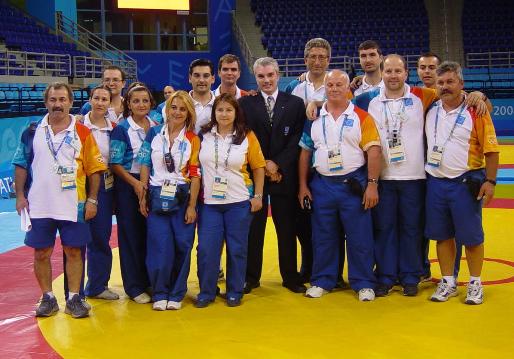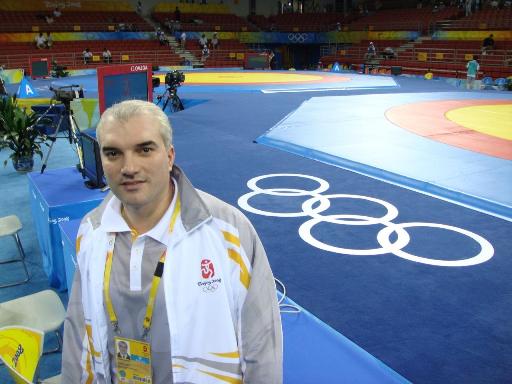
Dr. Babak Shadgan (pictured in centre), clinical researcher with the orthopedic trauma division, urologic sciences department, and muscle biophysics at Vancouver Coastal Health, and sports physician, with members of the Athens 2004 Olympic Game wrestling medical support team.
Submitted by VCH Research Institute
During the 2012 Summer Olympic Games in London this July, Dr. Babak Shadgan, clinical researcher with the orthopedic trauma division, urologic sciences department, and muscle biophysics at Vancouver Coastal Health, and sports physician, will be among the medical officials supporting the health and safety of the world’s top athletes.
Working as a medical and doping control officer with FILA, the international wrestling federation, Dr. Shadgan will supervise the medical support team and doping control testing of Olympic wrestlers during the 2012 Games. In addition, he will monitor all wrestling competitions in London and collect data categorizing injuries according to their mechanism, type, and severity. This data will form the basis for a surveillance study assessing the rate of injury and development of evidence-based policy recommendations to better protect athletes.
Shaping competition
London 2012 is Dr. Shadgan’s third analysis of Olympic wrestling injuries. His first report on the 2004 Athens Games found a high rate of injury and advocated changes to the competition format. Changes included stiffer penalties for dangerous actions, better training of athletes, coaches, and referees to prevent and recognize injuries, and shorter matches that place less strain on athletes and incorporate recovery time. The changes were implemented at the Beijing Games in 2008 and made an immediate impact – fewer and less severe injuries were observed.
Following Beijing, Dr. Shadgan again analyzed competition injury data and published the first scientific study of Olympic wrestling injuries in the high-impact American Journal of Sports Medicine. His follow-up study in London will build on this work with the hope of using evidence to further reduce injuries in wrestling and other sports over time.
Olympic inspiration – and novel injury diagnostics
Dr. Shadgan’s Olympic experiences have played a critical role in influencing his research career. During the 2004 Olympic Games, he worked with a former gold medalist who was forced to withdraw from competition because of pain in his leg due to chronic exertional compartment syndrome of the leg. The only diagnostic procedure for this condition was difficult and highly invasive, prompting Dr. Shadgan to explore alternative approaches.
Inspired by this challenge, Dr. Shadgan proposed a non-invasive diagnostic method based on near-infrared spectroscopy (NIRS). This optical technology uses pulses of light to measure changes in the oxygenation and hemodynamics of tissue, allowing accurate diagnosis of a range of conditions including compartment syndrome.
New applications – NIRS and bladder health
Dr. Shadgan is now working to apply the NIRS methodology for non-invasive diagnosis of bladder dysfunction as a post-doctoral fellow with ICORD spinal cord research program at VGH. Supported by a 2011 MSFHR/Rick Hansen Trainee award, he has developed a technique using a small wireless device – about the size of a mobile phone – that emits a wavelength that penetrates the bladder and returns information about its pathology. This novel, simple, and inexpensive technique has the potential to improve diagnosis and monitoring of bladder conditions, which are a major complication worldwide, particularly in people with spinal cord injuries.
For his innovative use of NIRS, Dr. Shadgan, was awarded the 2010 D.J. Lovell Scholarship, the most prestigious academic award presented by the International Society of Optics and Photonics (SPIE) and was recently promoted to the SPIE Senior Member rank. He is also a 2009 VCH Research Institute Rising Star winner.
For more information on VCH Research, click here.

